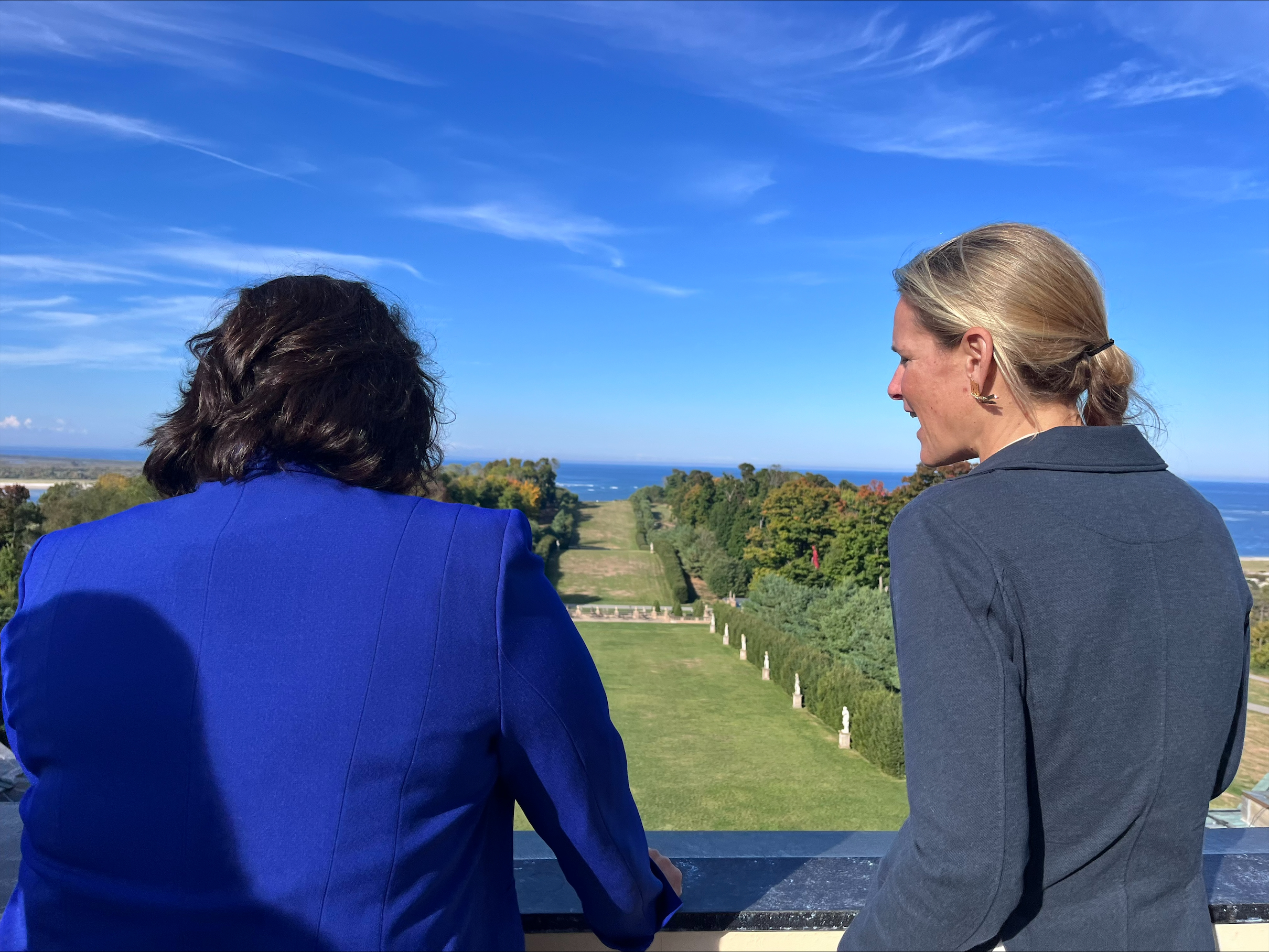
Partners including Governor Maura Healey and Lt. Governor Kim Driscoll pose for a photo on the roof of Castle Hill overlooking the Great Marsh
The Trustees was excited to host Massachusetts Governor Maura Healey and Lt. Governor Kim Driscoll, among several other officials, at the Crane Estate in Ipswich, Monday, September 30, 2024. The group, convened by Representative Kristin Kassner, 2nd Essex, engaged in lively discussion about the Great Marsh and the vulnerability of this critical ecosystem in the face of climate change. Partners in the project brought collaborative ideas to advance restoration and resilience work at a larger scale and address barriers to implementation. And of course, no visit to the Crane Estate would be complete without a trip to the iconic roof of Castle Hill to view the Great Marsh.
Attendees included leaders of Mass. Audubon Society, Essex Greenbelt, Mass Wildlife, United States Fish and Wildlife Services, Department of Fish and Game Commissioner Tom O’Shea, Department of Environmental Protection Commissioner Bonnie Heiple, and Senior Advisor for Intergovernmental Affairs Sarah Peake, among other legislators, community leaders, and partners.
“The hope was to bring together all of the partners to experience the Great Marsh and discuss the importance of collaboration to continue to work to successfully restore this unique and special ecosystem,” said Representative Kassner in a press release issued by her office. “I am so thankful to the many agencies and legislators for attending this discussion.”

Lead Ecologist at the Trustees, Russ Hopping, speaks during a legislative briefing
In Conversation About the Marsh
Governor Healey and Lt. Governor Driscoll joined the group after a legislative briefing to share in discussion about achievements in the restoration of the great marsh, current objectives, and hurdles to overcome.
“We want [the marsh] to be great forever, and we don’t want to see it go anywhere in terms of degradation,” shared Governor Healey at the event. “We want to do everything we can to preserve [the marsh] and to work together. One of the nice things about this state is, we’ve got great partnerships represented by all the stakeholders here.” she continued.
“The work that we can do to preserve and enhance the marsh is only going to help with so many other ecosystems as we think about our biodiversity goals are putting more attention in that space,” added Lt. Governor Kim Driscoll in her remarks. She conveyed her eagerness to work with the partners convened to “grow and thrive as a Commonwealth, and make sure spaces like [the Great Marsh] are preserved and enhanced.”
“That’s the real push and pull of this effort,” Driscoll continued. “I think we’ve got the right people not only here today, but frankly across Massachusetts who can help us do it, including you, Katie [Theoharides], and the work that you’re doing at The Trustees trying to bring to bear opportunities for us to partner in more and more ways.”

From left to right: Cynthia Dittbrenner, VP of Conservation and Resilience at the Trustees, Rep Kristin Kassner, Governor Maura Healey, and Lt. Governor Kim Driscoll

President and CEO of the Trustees, Katie Theoharides offers remarks
Restoration Efforts
The Great Marsh is the largest contiguous salt marsh in New England at more than 16,000 acres. The Trustees alongside several partners are at the forefront of innovative restoration work, healing the marsh with nature-based solutions. A legacy of agricultural embankments and ditching has left the marsh vulnerable to sea level rise. The Trustees, along with the project team of partners, are using a simple approach to restore tidal hydrology allowing the marsh to heal itself and build in elevation naturally. The innovative yet simple approach uses runnels, small channels, to drain impounded water, and salt marsh hay to heal unnecessary ditches by trapping sediment. Without restoration, the Great Marsh is projected to convert to low marsh before 2070 and tidal flats before 2100.
Work on the Great Marsh has resulted in the completed restoration of 215 acres and paved the way for restoration of an additional 8,000 acres currently in process. Permitting remains one of the primary roadblocks to continuing this work and was a large focus of the gathering on the 30th.

Great Marsh partners engaged in a conversation overlooking the marsh
One element of that permitting process is a Wetlands Restriction Order that pre-dates the Wetlands Protection Act and is effectively obsolete, does not allow for restoration. Rep. Kassner filed legislation (H.5036) to allow restoration projects to continue if properly permitted through Mass DEP. This bill has been reported favorably by the Committee on the Environment and Natural Resources and by the Steering Committee and is now in Bills in the Third Reading.
“At 16,000 acres the Great Marsh is the largest coastal wetland in New England and critical for fisheries and wildlife habitat, coastal resiliency, and carbon sequestration,” said Katie Theoharides, president and CEO of The Trustees. “The work our organization has done to restore the marsh’s hydrological function is critical to the fight against climate change, as oceans rise and storms intensify. I want to thank Representative Kassner for convening policymakers and state leaders to highlight the importance of nature-based solutions to climate change and to thank the Healey-Driscoll Administration for their leadership to combat climate change, invest in communities and protect our natural world.”

Lt. Governor Driscoll, Rep Kassner, and Governor Healey

President and CEO Katie Theoharides chats with Lt. Governor Driscoll



